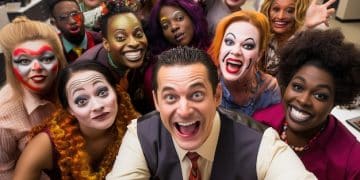The Evolution of Reality TV: From Humble Beginnings to Billion-Dollar Industry

The journey of reality television, a genre once dismissed as fleeting entertainment, astonishingly transformed from niche programming into a global, multi-billion-dollar industry, reshaping media consumption and celebrity culture along the way.
Few genres have ignited as much debate, fascination, and cultural impact as reality television. What began as a quirky, low-budget experiment in the late 20th century has exploded into a global phenomenon, fundamentally reshaping media landscapes and creating a new breed of celebrity. Understanding The Evolution of Reality TV: From Humble Beginnings to Billion-Dollar Industry offers a unique lens into modern society’s desires, technological advancements, and the relentless pursuit of entertainment.
The Dawn of Unscripted Drama: Early Pioneers and Their Impact
Reality television, in its nascent stages, was far from the polished, high-stakes productions we see today. It emerged from a blend of social experimentation and economic practicality, often utilizing minimalist sets and amateur participants to tell compelling, albeit raw, stories. These early shows laid critical groundwork.
One of the earliest and most influential examples was “An American Family,” which aired on PBS in 1973. This documentary series chronicled the lives of the Loud family over seven months, offering an unprecedented, unvarnished look at their dynamics, including a divorce. While not commercially driven in the way modern reality TV is, it demonstrated the compelling power of observing real lives unfold.
Pioneering Formats Emerge
The late 1980s and early 1990s saw the development of various formats that would become staples. Shows like “Cops,” premiering in 1989, brought law enforcement into living rooms with handheld cameras, showcasing real crimes and arrests. This “fly-on-the-wall” approach was revolutionary, offering a gritty authenticity rarely seen on television.
Another pivotal moment was “The Real World,” launched by MTV in 1992. This series brought together a diverse group of strangers to live in a single house, capturing their interactions, conflicts, and personal growth. It pioneered the “sizzle reel” approach to editing, shaping narrative from seemingly mundane daily life, and effectively launched the concept of unscripted drama for entertainment purposes.
- “An American Family” (1973): Broke ground with intimate family portrayal.
- “Cops” (1989): Introduced the direct observational, vérité style.
- “The Real World” (1992): Defined the “group living” social experiment.
These initial endeavors, though diverse in their specific content, shared a common thread: a compelling curiosity about the unvarnished human experience. They hinted at a desire within the audience to witness authenticity, even if that authenticity was subtly shaped by the presence of cameras and the editing process. This initial success signaled a shift in viewer preferences.
The low production costs associated with these formats also made them attractive to networks. Unlike scripted dramas or sitcoms that required expensive writers, actors, and elaborate sets, reality shows could be filmed with smaller crews and less pre-production, making them a cost-effective alternative to fill programming schedules. This economic incentive would prove crucial for its future growth.
The impact of these shows went beyond just entertainment. They sparked conversations about privacy, ethics in media, and the very definition of “reality.” Critics questioned the manipulation inherent in editing, while audiences reveled in the perceived authenticity. This tension became a hallmark of the genre that endures to this day.
The Reality Explosion: Global Reach and Diverse Genres
The turn of the millennium witnessed an unprecedented surge in reality television’s popularity, transforming it from a niche programming choice into a global entertainment juggernaut. This era was characterized by an explosion of new formats and a significant expansion into international markets, cementing reality TV’s place in mainstream culture.
The year 2000 was a watershed moment with the premiere of “Survivor” in the United States. This show, an adaptation of the Swedish format “Expedition Robinson,” took contestants to a remote location to compete for a cash prize, testing their physical and social resilience. Its blend of strategic gameplay, dramatic eliminations, and human interest stories captivated millions, becoming an instant cultural phenomenon.
Following “Survivor’s” immense success, networks scrambled to find their own reality hits, leading to a rapid diversification of genres. Competition shows, exemplified by “American Idol” (2002), democratized stardom, allowing everyday people to showcase their talents and vie for fame. This “Cinderella story” narrative resonated deeply with audiences.
- “Survivor” (2000): Solidified the competition/elimination format.
- “American Idol” (2002): Pioneered talent competition and audience participation.
- “The Apprentice” (2004): Blended business acumen with competitive tasks.
Concurrent to this explosion was the rise of lifestyle and home transformation shows. Programs like “Extreme Makeover: Home Edition” (2003) tapped into aspirational themes of self-improvement and community spirit, offering heartwarming narratives that balanced the often-cutthroat nature of competition shows. These programs demonstrated the genre’s versatility beyond simple observation or rivalry.
The appeal of reality TV transcended geographical boundaries. Formats were eagerly bought and adapted by broadcasters worldwide, leading to a truly global phenomenon. “Big Brother,” originating in the Netherlands in 1999, became a global franchise, with versions popping up in dozens of countries, locking contestants in a house for weeks or months while cameras observed their every move. This widespread adoption highlighted the universality of human drama and the voyeuristic appeal of watching others navigate social challenges.
The integration of audience participation, particularly through phone-in voting on shows like “American Idol,” further deepened viewer engagement. This interactive element made audiences feel like active participants in the outcome, fostering a stronger connection to the contestants and the narratives. It effectively transformed passive viewing into an interactive experience.

As the genre matured, it also began to explore more niche areas, including dating shows, makeover programs, and even shows focused on professional industries. This continuous innovation in format ensured that reality television remained fresh and captivating to an ever-evolving audience, preventing stagnation and pushing creative boundaries. The sheer variety established a blueprint for future growth.
The Rise of Reality Stars and Celebrity Culture
One of the most profound impacts of reality television has been its role in democratizing celebrity and fundamentally altering the landscape of fame. Before reality TV, celebrity was largely confined to actors, musicians, and public figures. Reality shows created a new pathway to stardom, often for individuals with no prior entertainment industry experience, turning everyday people into household names.
The phenomenon began humbly, with participants from early shows like “The Real World” gaining minor recognition. However, as the genre exploded with hits like “American Idol” and “Survivor,” contestants found themselves thrust into the national spotlight, with fan bases rivalling those of established entertainers. For many, these platforms served as springboards to careers in music, acting, or media.
From Screen to Empire: The Kardashain Phenomenon
No discussion of reality TV’s impact on celebrity is complete without mentioning “Keeping Up with the Kardashians.” Debuting in 2007, this show transformed an entire family into global icons, leveraging their personal lives and entrepreneurial ventures into a multi-billion-dollar empire. Their success demonstrated the immense financial potential of reality-generated fame.
The Kardashians’ business model became a blueprint for others: use the show to build a personal brand, then monetize that brand through endorsements, product lines, and social media. This blurred the lines between entertainment and commerce, making the stars themselves powerful marketing tools. Their show cemented the idea that a “reality star” could be just as influential, if not more so, than traditional celebrities.
The rise of reality stars also coincided with, and largely fueled, the burgeoning influence of social media. Platforms like Instagram, Twitter, and Facebook became extensions of their televised personas, allowing direct engagement with fans, offering behind-the-scenes glimpses, and serving as powerful marketing channels. This created a 24/7 celebrity culture, where the line between their “real” lives and their manufactured images became increasingly tenuous.
- Democratization of Fame: Anyone could become a star.
- Brand Building: Shows as platforms for personal and commercial ventures.
- Social Media Synergy: Amplification of fame and direct fan engagement.
This new breed of celebrity, often criticized for being “famous for being famous,” nonetheless captured immense cultural capital. Their influence extends to fashion, beauty, politics, and consumer trends. The relationship between reality shows and social media created a feedback loop: shows generated initial fame, social media amplified it, and the amplified fame in turn drew more viewers to the shows. This symbiotic relationship solidified their place in the modern pop culture pantheon.
Moreover, the concept of a “reality star” diversified. It wasn’t just about winning a competition or being part of a family saga; it was about developing a unique persona, generating buzz, and maintaining relevance. This constant pressure to perform and innovate, even in one’s personal life, became a defining characteristic of this new celebrity paradigm.
Innovation and Adaptation: Streaming, Social Media, and Niche Audiences
As the media landscape evolved with the advent of streaming services and the pervasive influence of social media, reality television demonstrated a remarkable capacity for innovation and adaptation. This era saw the genre transcend traditional broadcast networks, finding new homes and new ways to engage increasingly fragmented audiences.
Streaming platforms, unburdened by traditional advertising models and FCC regulations, provided fertile ground for reality TV to experiment. Shows like “Love Is Blind” (Netflix) and “Selling Sunset” (Netflix) broke away from the weekly release schedule, dropping entire seasons at once, which catered to binge-watching habits. This shift allowed for deeper character development and narrative arcs.
Diversifying Content for Every Niche
The move to streaming also enabled a greater focus on niche audiences. Where traditional networks aimed for broad appeal, streamers could greenlight shows catering to very specific interests or demographics. This led to a flourishing of diverse subgenres, from luxury real estate to unconventional dating experiments, ensuring there truly was a reality show for almost everyone.
Social media became more than just a promotional tool; it became an integral part of the show’s narrative. Live-tweeting episodes, Instagram stories from cast members, and TikTok challenges related to show moments created a multi-platform viewing experience. This real-time interaction and community building deepened viewer engagement and extended the show’s lifespan beyond its airtime.
- Binge-Watching Formats: Full season drops for immediate consumption.
- Niche Targeting: Tailoring content for specific audience segments.
- Social Media Integration: Real-time interaction and community building.

Producers also began to experiment with the very definition of “reality.” Shows incorporated user-generated content, interactive elements, and even blurred the lines between traditional documentary and structured reality, reflecting a more fluid understanding of storytelling in the digital age. This push tested the boundaries of what viewers considered authentic.
The rise of influencers and content creators on platforms like YouTube and TikTok further enriched the reality TV ecosystem. Many such creators gained followings by reacting to or discussing reality shows, effectively becoming a parallel commentary track. This organic commentary extended the reach and cultural footprint of the genre, turning individual shows into broader conversational topics.
Ultimately, reality television’s ability to adapt to new technologies and consumption habits has been key to its continued dominance. By embracing streaming, leveraging social media, and catering to specialized interests, it has proven to be a remarkably resilient and evolving form of entertainment, constantly reinventing itself to stay relevant in a fast-paced digital world.
Critiques and Controversies: The Darker Side of Reality TV
While reality television has soared in popularity and economic success, its journey has been far from smooth. The genre has consistently faced significant criticism and been embroiled in numerous controversies, raising fundamental questions about ethics, mental health, and the authenticity of its narratives.
A primary ethical concern revolves around the exploitation of participants. Many argue that individuals, particularly those vulnerable or seeking fame, are manipulated by producers to create dramatic situations. The pursuit of compelling television often overshadows the well-being of the cast, leading to emotional distress, public humiliation, and long-term psychological impacts on participants. Instances of mental health crises and even suicides linked to reality TV participation have fueled these criticisms.
The Illusion of Reality: Manipulation and Staging
The “reality” in reality TV has always been a point of contention. Critics frequently highlight the heavy editing, retakes, produced scenarios, and even outright staging that occur behind the scenes. This manipulation creates a narrative that, while entertaining, often bears little resemblance to the participants’ actual lives or interactions. This blurring of lines between genuine unscripted moments and fabricated drama can mislead viewers and foster distrust.
The portrayal of stereotypes and the promotion of unrealistic lifestyles are other significant critiques. Some shows are accused of perpetuating harmful stereotypes for comedic or dramatic effect, particularly concerning gender, race, and socioeconomic status. Others present an unattainable standard of living or beauty, potentially contributing to body image issues and materialistic anxieties among viewers.
- Exploitation of Participants: Ethical concerns over manipulation and psychological impact.
- Lack of Authenticity: Heavy editing and staging undermining “reality.”
- Stereotyping and Unrealistic Portrayals: Promoting harmful narratives or unattainable ideals.
Legal battles involving participants, allegations of wrongful editing, and public outcry over on-screen incidents have become almost as common as the shows themselves. These controversies often spark intense media scrutiny and force networks and production companies to address issues of participant welfare and ethical broadcasting, though progress can be slow and inconsistent.
Furthermore, the impact on broader societal values is frequently debated. Critics argue that the genre promotes negativity, conflict, and superficiality, sometimes glorifying poor behavior or rewarding dramatic outbursts. This raises questions about what kind of role models or behaviors are being implicitly endorsed to a mass audience, particularly impressionable younger viewers.
Despite these persistent critiques, the genre continues to thrive, a testament to its enduring appeal and adaptability. However, these controversies serve as a crucial reminder that the pursuit of entertainment, especially when dealing with real lives, carries significant responsibilities and ethical considerations that cannot be ignored.
The Billion-Dollar Business: Economic Impact and Future Trends
Beneath the on-screen drama and celebrity fanfare, reality television operates as a highly lucrative, multi-billion-dollar industry, driving immense economic value through production, advertising, and ancillary revenues. Its cost-effectiveness and broad appeal have made it a cornerstone of media business models globally.
From a production standpoint, reality shows are often significantly cheaper to produce than scripted series. They typically don’t require expensive writers’ rooms, A-list actors’ salaries, or elaborate special effects. This lower barrier to entry for production companies allows for higher profit margins, making them attractive investments for networks and streaming platforms looking to fill extensive content libraries.
Advertising Powerhouse and Ancillary Revenue Streams
Reality TV’s massive viewership translates directly into significant advertising revenue. Brand integrations, product placements, and commercial breaks during popular shows command premium rates. Advertisers are drawn to the often-dedicated and engaged fan bases, seeing reality shows as effective vehicles to reach target demographics.
Beyond traditional advertising, the industry generates substantial income through various ancillary streams. Merchandise sales, spin-off shows, syndication deals, and international format sales contribute significantly to the genre’s bottom line. The fame generated by reality stars also sparks new ventures, from cosmetic lines to clothing brands, further expanding the economic ripple effect.
- Cost-Effective Production: Lower overheads compared to scripted content.
- Advertising Revenue: High viewership attracting premium ad rates.
- Diversified Income: Spin-offs, merchandise, and international format sales.
Looking ahead, the future of reality television appears robust, driven by continued innovation in technology and audience engagement. Interactive elements, such as audience voting and real-time social media integration, are likely to become even more sophisticated, blurring the lines between viewers and participants.
The rise of hyper-personalized content, fueled by data analytics, could lead to even more niche and algorithm-driven reality formats. Virtual and augmented reality might offer immersive viewing experiences, allowing audiences to “step into” the reality show environment. The metaverse, too, presents a potential new frontier for reality TV, allowing for fully immersive, interactive social experiments.
Investment in reality content from streaming giants like Netflix, Amazon Prime Video, and Hulu continues to grow, signaling confidence in the genre’s enduring appeal. This competitive landscape is driving further experimentation and higher production values, ironically pushing some reality shows to look more like scripted dramas.
Ultimately, reality television’s economic engine is fueled by its capacity to adapt, its relatively low production costs, and its ability to consistently tap into the universal human desire for drama, connection, and aspirational living. As technology advances and audience tastes evolve, reality TV seems poised to continue its reign as a powerful and profitable force in the global entertainment industry.
The Cultural Footprint: From Guilty Pleasure to Academic Subject
The impact of reality television extends far beyond entertainment and economics; it has carved out a significant and often contentious cultural footprint, evolving from a dismissed “guilty pleasure” to a legitimate subject of academic study and critical analysis.
Initially, reality TV was often derided by critics and considered low-brow entertainment. It was viewed as superficial, manipulative, and a sign of declining cultural standards. This perception led many to consume it discreetly, labeling it a “guilty pleasure” – something enjoyed despite perceived lack of intellectual merit.
Shifting Perceptions and Academic Inquiry
However, as the genre matured and its pervasive influence became undeniable, attitudes began to shift. Sociologists, media theorists, and cultural critics started to recognize its significant role in shaping public discourse, influencing social norms, and reflecting contemporary anxieties and aspirations. What was once dismissed as filler programming began to be analyzed for its deeper implications.
Academic institutions now offer courses and research opportunities dedicated to reality television. Scholars examine its narrative structures, its impact on identity formation, its reflection of gender and class dynamics, and its role in the commodification of everyday life. This shift indicates a growing understanding of reality TV not merely as entertainment, but as a powerful cultural artifact deserving of serious consideration.
- Initial Dismissal: Categorized as low-brow “guilty pleasure.”
- Socio-Cultural Reflection: Mirroring and influencing societal norms.
- Academic Recognition: Subject of serious study and critical analysis.
The genre has also inadvertently spurred conversations about identity, representation, and diversity. While often criticized for perpetuating stereotypes, some shows have also provided platforms for underrepresented communities or explored topics related to gender fluidity, disability, and diverse family structures, sparking important dialogues in mainstream media.
Reality TV’s influence on language and common parlance is also notable. Phrases, catchphrases, and even specific gestures from popular shows frequently permeate everyday conversation and social media trends. This demonstrates how deeply embedded the genre has become in the collective consciousness, shaping informal communication and cultural references.
Moreover, the genre has fundamentally altered our understanding of “authenticity” and performance. With participants aware of cameras and editing, the line between their “real” selves and their constructed personas becomes increasingly blurred, leading to broader questions about the nature of celebrity and public identity in the digital age. This self-awareness within the genre adds another layer of complexity to its cultural impact.
From its humble beginnings, reality television has achieved a remarkable feat: it transcended its initial reputation to become a powerful cultural force, influencing everything from celebrity to academic discourse. It continues to challenge, entertain, and provoke, ensuring its lasting presence in the cultural landscape.
| Key Point | Brief Description |
|---|---|
| 🎬 Early Beginnings | From documentary-style shows like “An American Family” to competitive formats, setting foundational elements. |
| 🌟 Celebrity Creation | Transformed ordinary individuals into global icons, especially with shows like “Keeping Up with the Kardashians.” |
| 💻 Digital Adaptation | Thrived by adapting to streaming platforms and social media, fostering niche content and interactive viewing. |
| 💰 Economic Powerhouse | A multi-billion-dollar industry built on cost-effective production, massive advertising revenue, and diverse ancillary streams. |
Frequently Asked Questions About Reality TV Evolution
▼
While definitions vary, “An American Family” (1973) on PBS is widely credited as one of the earliest examples of reality television. It documented the lives of the Loud family, offering an unscripted, direct observation of their daily lives and challenges, including a divorce. It pre-dated the commercialized reality TV we know today, but established the concept of capturing real-life events for television.
▼
Reality TV’s transformation into a billion-dollar industry stems from its cost-effectiveness, mass appeal, and diversification of revenue. Lower production costs compared to scripted shows, coupled with high viewership, attracted significant advertising. The success of major franchises like “Survivor” and “American Idol,” along with spin-offs, merchandise, and international format sales, solidified its economic powerhouse status, especially with digital streaming furthering its reach.
▼
Social media plays a crucial and multifaceted role in modern reality TV, amplifying its reach and engagement. It serves as a continuous platform for cast members to interact with fans beyond the show’s airtime, share behind-the-scenes content, and build personal brands. For viewers, it facilitates real-time discussion, fan theories, and community building, enhancing the overall viewing experience and extending the show’s cultural impact.
▼
The “reality” in reality TV is a subject of ongoing debate. While featuring unscripted moments and real individuals, most shows involve significant production intervention. This includes heavy editing, retakes, constructed scenarios, and producer prompts designed to create drama and compelling narratives. Participants’ interactions can also be influenced by the presence of cameras and the desire for screen time, blurring the line between authentic behavior and performance.
▼
Reality TV has profoundly influenced traditional celebrity culture by democratizing fame and creating a new pathway to stardom. It transformed ordinary individuals into household names and established the concept of “famous for being famous.” This allowed reality stars to build multi-million-dollar empires through personal branding, endorsements, and social media, effectively reimagining what it means to be a modern celebrity and often overshadowing traditional actors or musicians in influence.
Conclusion
From its experimental origins documenting family life to its current status as a global, multi-billion-dollar juggernaut, the evolution of reality television is a vivid narrative of media innovation, cultural adaptation, and audience engagement. It has fundamentally reshaped celebrity, redefined entertainment economics, and provoked profound discussions about authenticity and ethics. Far from a passing fad, reality TV’s enduring appeal lies in its dynamic ability to reflect and manipulate human drama, ensuring its place as a powerful force in the evolving media landscape for years to come.





